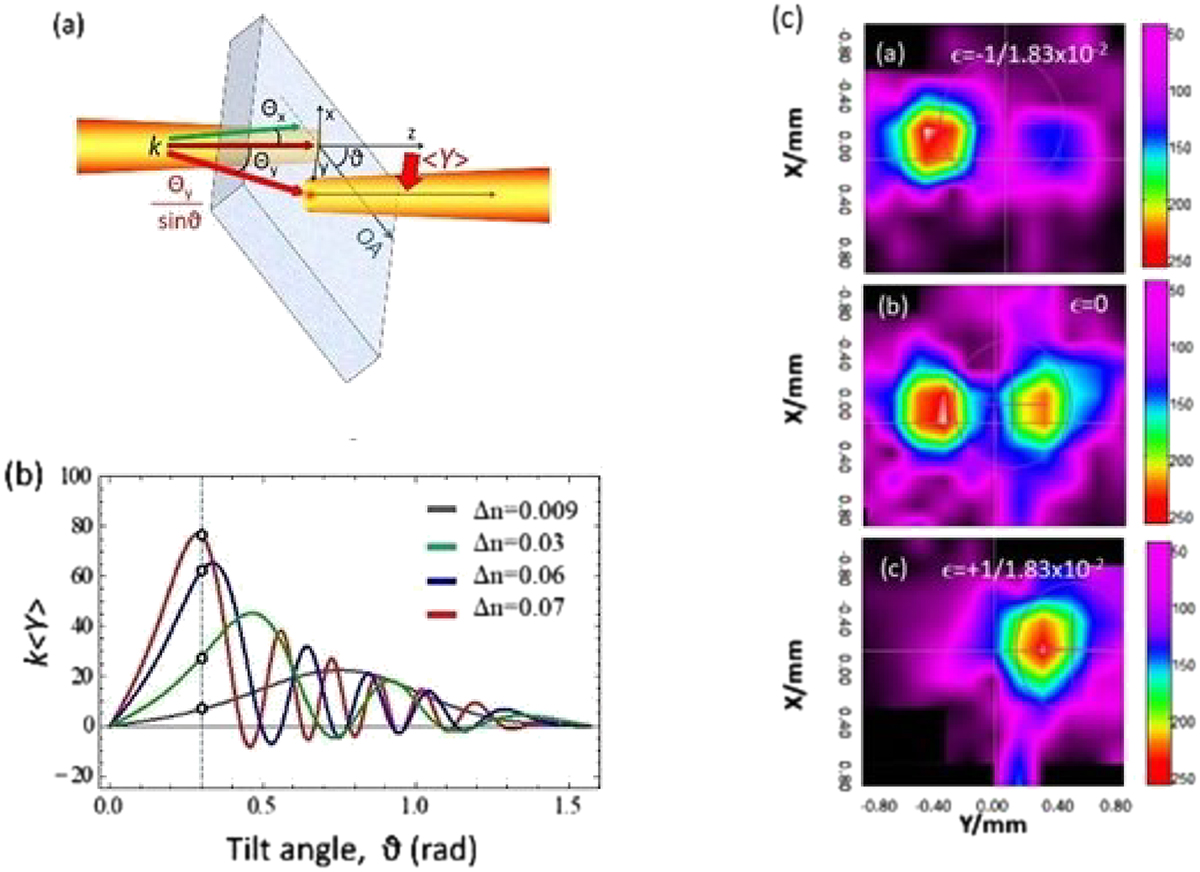Figure 4

Download original image
(a) Paraxial beam’s transmission through a clear birefringent polymer slanted layer as shown in 3D geometry. The beam goes through transversal shift ![]() at the nanometer scale brought on by the Spin Hall Effect (SHE) of light. The paraxial angles (Θx, Θy) identify the propagation direction of the incident beam’s wave vectors k. (b) A tunable birefringent polymer results in enhanced SHE of light as shown in numerical simulations considering different birefringence: Δn 0.009 (gray, index difference in quartz), Δn 0.03 (green), Δn 0.06 (blue), and Δn 0.07 (red, index difference in stretched polymers [29]). Vertical dashed line at ν 0.3 (rad) is to show the tunability of beam shift by different birefringence. (c) Transverse intensity distributions (a.u.) in false scale for an o-polarized beam transmitted through a tilted polymer plate and post-selected in the almost e-polarized state, with a tilt angle ϑ = 20°. Top: Post-selected polarization state with ϵ = −1/83 × 10−2. The beam centroid is shifted, resulting in a measurement of weak value
at the nanometer scale brought on by the Spin Hall Effect (SHE) of light. The paraxial angles (Θx, Θy) identify the propagation direction of the incident beam’s wave vectors k. (b) A tunable birefringent polymer results in enhanced SHE of light as shown in numerical simulations considering different birefringence: Δn 0.009 (gray, index difference in quartz), Δn 0.03 (green), Δn 0.06 (blue), and Δn 0.07 (red, index difference in stretched polymers [29]). Vertical dashed line at ν 0.3 (rad) is to show the tunability of beam shift by different birefringence. (c) Transverse intensity distributions (a.u.) in false scale for an o-polarized beam transmitted through a tilted polymer plate and post-selected in the almost e-polarized state, with a tilt angle ϑ = 20°. Top: Post-selected polarization state with ϵ = −1/83 × 10−2. The beam centroid is shifted, resulting in a measurement of weak value ![]() . Middle: With crossed polarizers (ϵ = 0), a Hermite-Gaussian intensity distribution with peaks spaced apart from one another by ΔY = 1000 μm is created from a Gaussian distribution, corresponding to a weak amplification factor A = 200. Bottom: Post-selected polarization state with ϵ = 1/83 × 10−2, which corresponds to a weak value measurement of
. Middle: With crossed polarizers (ϵ = 0), a Hermite-Gaussian intensity distribution with peaks spaced apart from one another by ΔY = 1000 μm is created from a Gaussian distribution, corresponding to a weak amplification factor A = 200. Bottom: Post-selected polarization state with ϵ = 1/83 × 10−2, which corresponds to a weak value measurement of ![]() .
.
Current usage metrics show cumulative count of Article Views (full-text article views including HTML views, PDF and ePub downloads, according to the available data) and Abstracts Views on Vision4Press platform.
Data correspond to usage on the plateform after 2015. The current usage metrics is available 48-96 hours after online publication and is updated daily on week days.
Initial download of the metrics may take a while.


